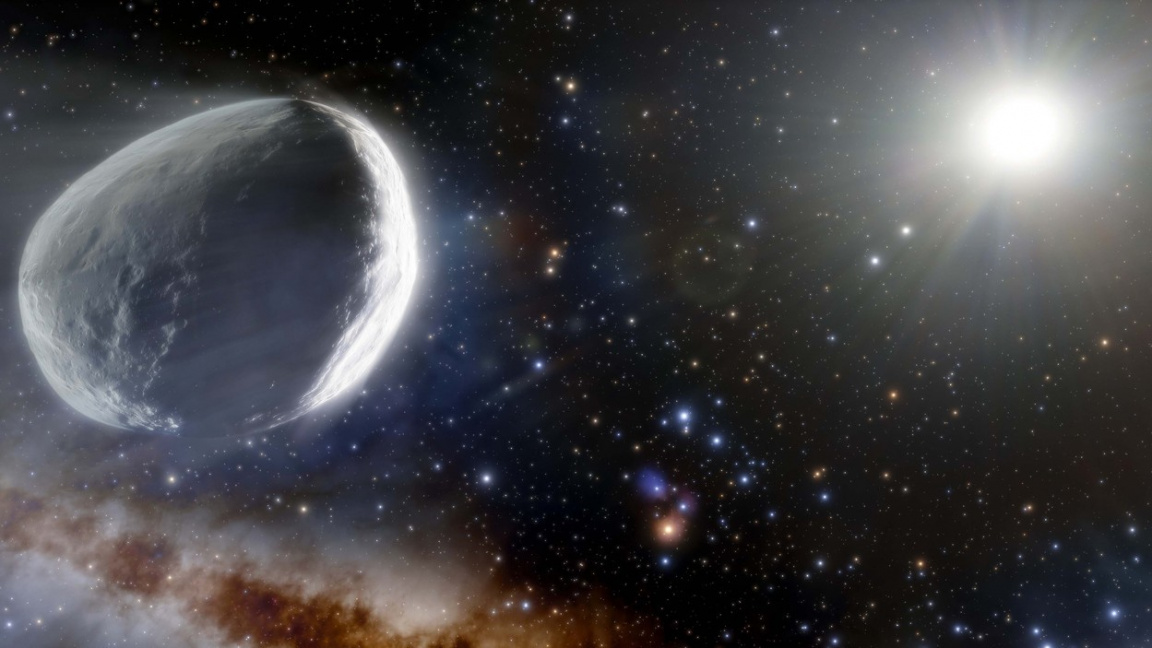From the periphery of the solar system is approaching the largest comet humans have ever observed
New observations show that a comet flies towards the Sun, which surpasses all the “hairs” observed so far. It is larger than originally expected. The clarity of the body shows that the diameter of its core measures about 150 kilometers.
It is called C / 2014 UN271 Bernardinelli-Bernstein after its discoverers – astronomers Pedro Bernardinelli and Gary Bernstein, who identified it in June this year.
The mistake of astronomers
The comet was first captured by telescopes in 2014. At that time, it was as far away from the Sun as Neptune, ie 4.5 billion kilometers, which is thirty times the Earth’s distance from the Sun. However, the object escaped attention. Astronomers mistakenly thought of it as an asteroid,
It wasn’t until Bernardinelli and Bernstein, who work for the Dark Energy Survey project on dark energy research, that it was a comet.
“We had the privilege of discovering perhaps the largest comet we have ever seen and capture it early enough to study and watch it approach and heat up,” Gary Bernstein said in June.
Comets, obsolete hairy, are bodies composed mainly of ice and dust. They orbit an eccentric elliptical orbit around the Sun. They are characterized by tails – comet particles pointing away from the sun.
–
Now Bernardinelli a Bernstein with a team of collaborators research the comet in detail in a study published in a magazine arXiv.
A pilgrim from the periphery
The space messenger arriving from the periphery of the solar system also surpasses the famous comet Hale-Bopp, which has a diameter of almost 80 kilometers and which performed a spectacular show in 1997. At that time, its double tail, one blue gas and the other yellowish dust was observed from Earth.
C / 2014 UN271 Bernardinelli-Bernstein will probably leave behind the largest comet close to us to date, the 100-kilometer Sarbat, which flew through the solar system in 1729. Not to mention most known comets that have a core size of “only” a few kilometers.
If it hit Earth, then it would be a comet Bernardinelli-Bernstein, could wipe out our civilization. But we don’t have to worry about that, the Earth will pass safely.
In the study, Bernardinelli and Bernstein calculated the trajectory of the comet they discovered. It was at its farthest point 1.5 million years ago. At that time, it was located at a distance of 40,400 AU (astronomical units, 1AU = 149,597,870.7 kilometers) from our star. It last approached the Sun 3.5 million years ago, before the beginning of our civilization. It was then separated from our star by 18 AU, ie 2.7 billion kilometers.
Now, according to calculations in the study, this colossus is closest to the Sun in 2031, when it should fly into the orbit of Saturn. This planet is an average of 1.42 billion kilometers from the Sun. (The Earth’s distance from the Sun is between 147 and 152 million kilometers.)
Then the comet flies back, to the dark periphery of the solar system, where it was born. There in an area called the Oort cloud, it was created by combining the remnants of the condensation of the solar nebula.
As it travels through the Oort cloud, frozen gases accumulate on the comet, which then forms a spectacular cometary tail as it travels closer to the Sun.
Comets may be a threat to the Earth, it has probably caused mass extinctions in the past. They are more dangerous than asteroids because they fly up to 3.5 times faster (up to 70 kilometers per second). The velocity increases to the second when calculating the kinetic energy of the impact, so the comet has more energy on impact than the asteroid and causes more damage.
–
Chemistry is billions of years old
According to earlier estimates, Comet Bernardinelli-Bernstein should have been as bright as Pluto. But now astronomers have raised the highest brightness estimates to the level of Titan, Saturn’s moon.
For astronomers, her visit to our neighborhood will be a welcome opportunity to explore it and learn more about its origins and the distant lands of the solar system.
Ice rocks from distant regions of our system have remained more or less unchanged since their inception, 4.5 billion years ago. Volatile substances trapped in the comet’s ice should therefore contain information about the chemistry of the outer solar system during its formation.
– .

:quality(80)/cdn-kiosk-api.telegraaf.nl/52f2267a-2426-11ec-ae86-0218eaf05005.jpg?resize=150%2C150&ssl=1)
